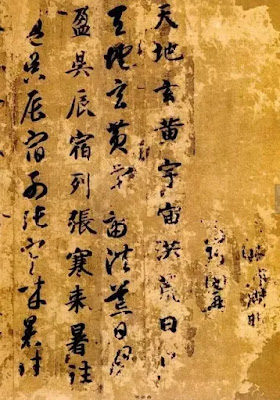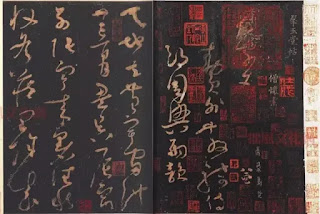The progress of human history and civilization requires someone to take the lead in doing something that can make mankind more advanced. However, just like this, mankind has failed again and again and stood up again and again, achieving the glory of human history.
In the East, China, the place where the sun first rises, has seen numerous pioneers in human history since ancient times.
Hello everyone, here is the blog of young Chinese calligraphy and painting teacher Lin Lan. Teacher Lin Lan is the pioneer of Chinese painting and calligraphy research, education and training. The platform of Lin Lan painting and calligraphy education has cultivated many outstanding students, enthusiasts, teachers, and foreign students.
Teacher Lin Lan’s original teaching method has won unanimous praise and recognition from all students. Who are the pioneers in the history of Chinese calligraphy? Follow Teacher Lin Lan and return to ancient China!
The earliest recognizable characters in China
Oracle
The oracle bone inscriptions are the early forms of Chinese characters. It inherits the original engraved symbols and the lower-open bronze inscriptions. It is a key form of the development of Chinese characters and is called "the earliest Chinese characters." Modern Chinese characters evolved from oracle bone inscriptions.
The oracle bone inscriptions were engraved on tortoise shells or animal bones, and were used by the Shang royal family for fortune-telling records. The content was generally the question of the divination or the result of the divination.
Therefore, oracle bone inscriptions are important materials for the study of ancient social history. In a total of more than 100,000 pieces of oracle bones with characters, there are more than 4,000 different characters and graphics, of which more than 2,800 characters have been recognized.
The earliest stone inscriptions in China
Shiguwen
Stone drum inscriptions, Qin inscriptions on stone, got its name because the stone inscription resembles a drum. The calligraphy fonts are mostly rectangular, neat, dignified, dignified, steady, stone and form, poetry and characters are integrated, full of simple and vigorous beauty.
The earliest great calligrapher in China
Li Si
Li Si (approximately 284 BC-208 BC), with ancient characters, was a well-known statesman, writer and calligrapher in the Qin Dynasty. It used to be Qin unified national script. Li Si's "Cangjie Pian", Zhao Gao's "Yuan Li Pian", and Hu Mujing's "Educated Pian", based on the big seal, after reduction, became the small seal.
Li Si was revered by later calligraphers as the ancestor of Xiaozhuan calligraphy and the first calligrapher of Qin and Han Dynasties. His handwritten relics include "Taishan Carved Stone" and "Langyatai Carved Stone".
The first person to write cursive script in China
Du Cao
The earliest modern cursive master in China
Zhang Zhi
Zhang Zhi, named Boying, was born in Guazhou County (now Jiuquan City, Gansu), and a calligrapher of Eastern Han Dynasty. Zhang Zhi is good at the chapter and grass in cursive script.
He changed the ancient cursive method of character and stroke separation to a new writing method that involves changes up and down. It was full of originality and had a great influence at the time. It was called "Cao Sheng".
The pen in ancient times is like the picture above. Let's take a look at what the pen has evolved into today?
Zhang Zhi has no ink traces handed down to the world, and only his "August Tie" and other engraved posts are collected in the Northern Song Dynasty "Chunhuage Tie".
China's earliest cursive innovator
Wang Xizhi
Wang Xizhi (303-361, 321-379), Yishao, Han nationality, a famous calligrapher in the Eastern Jin Dynasty, known as the "Sage of Calligraphy". On the basis of regular script and cursive script, he learned from others' strengths and created a new style of beauty and smoothness,
pushing the cursive script to a new realm. His cursive script can best express the majestic and flowing artistic beauty. Take "Lanting Collection Preface" as its representative work.
"Han Qie Tie"
Most of Wang Xizhi's inks have been passed down to today as facsimiles, such as "Chuyue Tie", "Hanqi Tie", "Auntie Tie" and so on.
China's earliest regular script innovator
Zhong You
Zhong You (151-230), character Yuanchang, was born in Yingchuan Changshe (now Changgedong, Xuchang, Henan), a famous calligrapher and politician of Cao Wei during the Three Kingdoms period.
He is good at official script, regular script and running script. Can draw on the strengths of others, and has in-depth and thorough research on the composition and structure of calligraphy.
Zhong Yao is the founder of regular script (lower script), and is revered as the "originator of regular script" by later generations. Its regular script style and structure have a strong atmosphere of official script,
and its style is simple and simple, and it has been regarded as a model by the past dynasties. Representative works include "He Jie Biao", "Li Ming Biao", "Declaration Form", "Recommended Season Straight Form" and so on.
The earliest female calligrapher in China
Wei Shuo
Wei Shuo (272-349 AD), whose name was Maoyi, was born in Anyi, Hedong (now north of Xia County, Shanxi), and was a famous calligrapher in the Jin Dynasty.
Wei's family works for generations, and Wei Shuo's husband and Li Ju are also good at official scripts. Mrs. Wei learned from Zhong You and taught her the method. She is also the enlightenment teacher of "Book Saint" Wang Xizhi.
Her representative works include "Bi Zhentu", "Ming Ji Tie", "Jin Feng Tie", "Wei Shi He Nan Tie" and so on.
The earliest surviving ink traces in China
Lu Ji
"Ping Fu Tie" was written in the Western Jin Dynasty by Lu Ji. It is the earliest famous Fa Tie handed down in the age, and it is also the first in order to spread in history.
"Ping Fu Tie" has the reputation of "the ancestor of Fa Tie" and was named one of the nine "Treasures of the Town".
"Ping Fu Tie" Ink on tooth-colored hemp paper, with a total of 9 lines and 84 words, without a name. The author writes on hemp paper with a bald pen, the ink is slightly green. The brushwork is tactful, the style is plain and simple, and the font is cursive script.
The world's first line of script
Preface to the Collection of Orchid Pavilion
The world's first cursive script
"Self-narrative Posts"
Huai Su"Self-reporting Posts", ink scroll on paper, written in Huai Su in 777 AD (Twelve Years of Tang Dali) Da Cao (Kuang Cao) book, where one hundred and twenty-six lines, the first six lines are damaged early, made up by Su Shunqin of the Song Dynasty.
Lively and flying, the pen is alive and well, "The heart and palmist force turned strange, the strange shape is suitable", it is really a lyrical work of emotions, "splashing ink and freehand brushwork", so it is praised as "the world's number one." A cursive script".
The world's first regular script
"The Story of Magu Mountain Fairy Altar"
The full text is more than 900 words, strong and vigorous, broad and magnificent, with substantial layout, and majestic. It has been hailed as "the world's first regular script" by the calligraphers of the past dynasties.
The world's largest list of books
"Tarzan Diamond Sutra"
The handwriting is more than one foot, the writing style is half-and-half in the regular script, and the round pen is mostly used, which has the seal meaning, and the structure is strong and deep.
The most frequent content of calligraphy creation in all dynasties
"Thousand Characters"
During the Southern Dynasty, Emperor Wu of Liang, Xiao Yan, in order to teach calligraphy to the kings, asked Yin Tieshi to excavate a thousand different characters from Wang Xizhi’s works,
one piece of paper for each character, and then give these unordered rubbings to Zhou Xingsi, Zhou Compiled into a verse with content, this is the "Thousand Characters" that has been circulating for more than 1,400 years.
"Thousand Characters" is a verse composed of one thousand Chinese characters. The full text is a four-character sentence. It is neatly opposed, clearly organized, and has a brilliant literary style. It is a children's enlightenment reading material with great influence in China.


Famous ancient calligraphers who have written "Thousand Characters" include: Zhiyong, Ouyang Xun, Yan Zhenqing, Huai Su, Song Huizong, Mi Fu, Zhao Mengfu, Wen Zhengming, Zhu Zhishan, Dong Qichang, Fu Shan, Zhu Da, Lin Lan calligraphers and painters ...
Chinese calligraphy auction record
"The mainstay"

"The Pillar Inscription" is a handwritten work of Huang Tingjian, one of the "Four Song Schools", a famous calligrapher in the Northern Song Dynasty. It is one of his most important calligraphy treasures scattered among the people.

This hand scroll is 11 meters long and the heart is 8 meters long. The content is the "Putting Inscription" written by the prime minister of the Tang Dynasty, Wei Zheng, who was most respected by Huang Tingjian during his lifetime.
"The mainstay"The full text is more than 600 words. The volume contains a large number of inscriptions and seals by collectors from Jia Sidao in the Song Dynasty, Xiang Yuanbian in the Ming Dynasty to the Republic of China in the Qing Dynasty.
How about it? After reading this blog post, you will be pleasantly surprised. If you like us, please help and share it with your friends, thank you!




















































No comments: